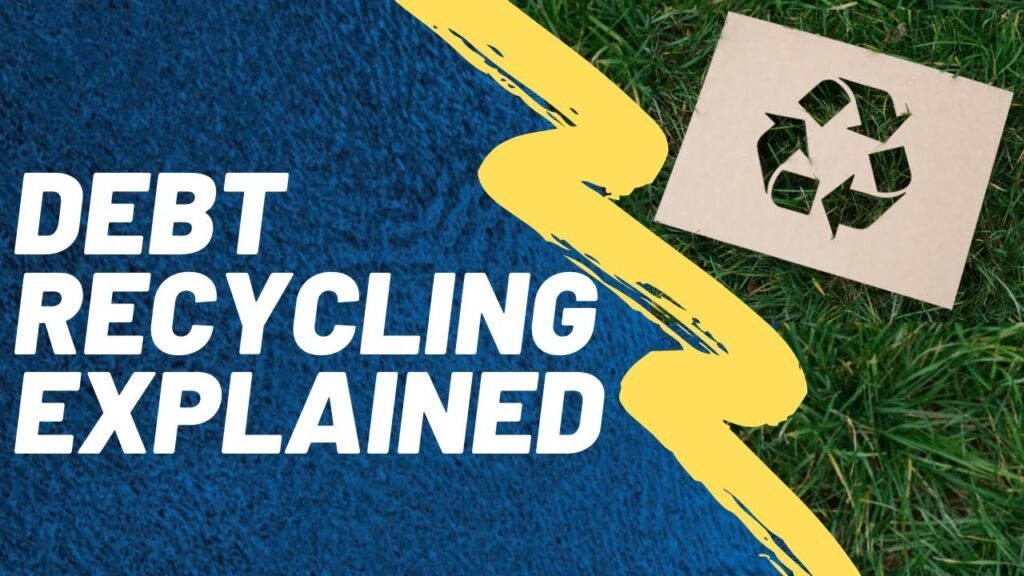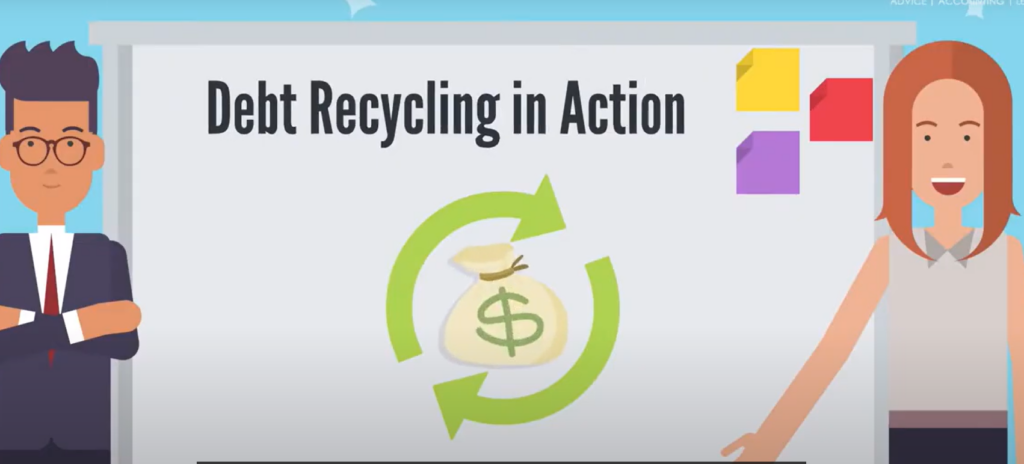Debt recycling is a financial strategy that allows individuals to leverage their existing debt to increase their wealth. It involves utilizing the equity in one’s property to invest in income-generating assets, such as shares or property, while simultaneously reducing non-deductible debt, such as mortgage or personal loans. This article aims to provide a comprehensive introduction to debt recycling, exploring its concept, benefits, risks, implementation, and legal aspects.
Understanding the Concept of Debt Recycling
In order to grasp the concept of debt recycling, it is essential to delve into its basics and mechanics. By doing so, individuals can gain a deeper understanding of is debt recycling worth it, how this strategy works and how it can potentially benefit them in the long run.
The Basics of Debt Recycling
At its core, debt recycling involves redirecting existing debt towards investments that have the potential to generate an income, ultimately aiming to increase overall wealth. This process typically consists of three key steps: identifying equity in one’s property, borrowing against that equity, and then investing the borrowed funds into income-producing assets.
Essentially, debt recycling allows individuals to transform non-deductible debt into deductible debt, potentially helping to reduce tax liability while building a diversified investment portfolio. Learn more how debt recycling transforming your financial landscape in Australia.

The Mechanics Behind Debt Recycling
The mechanics of debt recycling involve the interplay between borrowing, investing, and debt reduction. Firstly, individuals need to assess the equity they hold in their property – the portion of the property’s value that is not subject to any outstanding loans. This equity can then be used as collateral to secure additional loans, which are then directed towards acquiring income-generating assets.
By channeling borrowed funds into investments, individuals aim to achieve positive returns that not only offset the cost of the loan but also generate additional income. Over time, as the investment portfolio appreciates, the goal is to sell certain assets and use the proceeds to pay off existing non-deductible debt, effectively reducing overall debt and increasing equity.
Let’s take a closer look at an example to illustrate the mechanics of debt recycling. Imagine you own a property worth $500,000, with an outstanding mortgage of $200,000. This means you have $300,000 in equity. Instead of leaving that equity idle, you decide to borrow against it and invest the borrowed funds in a diversified portfolio of income-generating assets.
Over the next few years, your investments perform well, generating a steady stream of income. This income not only helps you cover the costs of the loan but also allows you to accumulate additional funds. As time goes on, the value of your investment portfolio appreciates, and you decide to sell some assets.
By selling these assets, you generate a lump sum of money that you can then use to pay off a portion of your non-deductible debt. This reduction in debt not only lowers your interest payments but also increases your equity in the property. As a result, you have effectively transformed non-deductible debt into deductible debt, reduced your overall debt burden, and increased your net worth.
It is important to note that debt recycling is a long-term strategy that requires careful planning and consideration. It is not a quick fix or a one-size-fits-all solution. Each individual’s financial situation is unique, and it is crucial to seek professional advice before embarking on any debt recycling strategy.
The Benefits of Debt Recycling
Debt recycling offers numerous financial advantages that make it an attractive strategy for wealth creation. Understanding these benefits is key to fully appreciating the potential value that debt recycling can bring to individuals in the long term.
Debt recycling is a strategic financial approach that involves leveraging existing assets to acquire additional income-generating investments. This method allows individuals to make the most of their financial resources by using borrowed funds to expand their investment portfolio. By diversifying their assets through debt recycling, individuals can potentially increase their overall wealth and financial stability over time.
Financial Advantages of Debt Recycling
One of the primary benefits of debt recycling is the potential to generate additional income through investments. By utilizing borrowed funds to acquire income-generating assets, individuals stand to benefit from capital appreciation, dividends, or rental income, depending on the chosen investment vehicle.
Another advantage lies in the potential tax benefits associated with debt recycling. By transforming non-deductible debt into deductible debt, individuals may be able to reduce their taxable income. This can lead to significant tax savings, further enhancing the overall financial outcome.

Moreover, debt recycling can also serve as a risk management tool. By spreading investments across different asset classes, individuals can mitigate the impact of market fluctuations on their overall financial position. This diversification can help protect against potential losses and enhance the resilience of their investment portfolio.
Long-Term Impact of Debt Recycling
Over the long term, debt recycling has the potential to accelerate wealth creation. By continuously redirecting borrowed funds towards investments, individuals can harness the power of compounding returns. As investments grow and debt is reduced, the cycle of debt recycling can be perpetuated, creating a self-sustaining wealth creation strategy.
Furthermore, the long-term impact of debt recycling extends beyond financial gains. By actively managing their debt and investments, individuals can develop a deeper understanding of financial markets and investment strategies. This hands-on approach to wealth creation can lead to increased financial literacy and a more secure financial future.
Risks Associated with Debt Recycling
While debt recycling can offer financial benefits, it is essential to understand the risks involved. Acknowledging these risks and taking appropriate measures to mitigate them is crucial for individuals considering the implementation of debt recycling strategies.
Potential Pitfalls of Debt Recycling
One of the significant risks associated with debt recycling is the volatility of investment markets. Investing borrowed funds carries inherent risks, as asset values can fluctuate, potentially resulting in capital losses. It is crucial to carefully consider the investment choices and diversify the portfolio to minimize risk exposure.
For example, let’s say you decide to invest in the stock market using debt recycling. While stocks have historically provided strong returns over the long term, they can also experience significant price swings in the short term. By diversifying your investments across different sectors and asset classes, such as bonds or real estate, you can reduce the impact of any single investment’s performance on your overall portfolio.
Additionally, changes in interest rates can impact the affordability and cost-effectiveness of debt recycling strategies. Rising interest rates may increase the cost of loans, potentially reducing the viability of debt recycling and impacting cash flow.
Consider this scenario: you have taken out a loan to invest in a property, and the interest rate suddenly rises. This increase in borrowing costs can put a strain on your finances, making it more challenging to meet your loan repayments and potentially affecting your ability to continue with the debt recycling strategy. It is crucial to factor in potential interest rate fluctuations and have a contingency plan in place to manage any adverse effects.

Mitigating Risks in Debt Recycling
To mitigate the risks associated with debt recycling, individuals should prioritize risk management and seek professional advice. Conducting thorough research on potential investment options, diversifying the portfolio, and setting realistic investment goals can help minimize the impact of market volatility.
Working with a financial advisor who specializes in debt recycling can provide valuable insights and guidance. They can help you assess your risk tolerance, analyze investment opportunities, and create a tailored strategy that aligns with your financial goals and circumstances.
Furthermore, regularly reassessing the suitability of debt recycling strategies and staying informed about changes in interest rates and market conditions can enable individuals to make necessary adjustments and mitigate potential risks.
Remember, debt recycling is not a one-size-fits-all approach, and it requires careful consideration and ongoing monitoring to ensure its effectiveness. By understanding the risks involved and implementing appropriate risk management strategies, individuals can navigate the debt recycling journey with confidence and potentially reap the financial rewards it offers.
How Debt Recycling Works in Practice
Understanding the practical aspects of debt recycling is crucial for successful implementation. By grasping the process and involving the key players, individuals can navigate debt recycling effectively and maximize its potential benefits.
The Process of Debt Recycling
The process of debt recycling typically begins with a thorough assessment of one’s property equity and suitability for leveraging. This involves estimating the value of the property and determining the available equity that can be used as collateral for borrowing.
Next, individuals need to identify suitable income-generating assets to invest in. This requires careful analysis of investment options, considering factors such as potential returns, risks, and liquidity.
Once the investments are made using borrowed funds, it is crucial to closely monitor the performance of the portfolio. Regular reviews and adjustments may be necessary to optimize returns and ensure the ongoing viability of the debt recycling strategy.
Key Players in Debt Recycling
Debt recycling often involves interactions with various professionals who play critical roles in its successful implementation. These may include financial advisors, mortgage brokers, accountants, and legal experts.
Financial advisors provide guidance on investment options and help individuals tailor their debt recycling strategies to suit their unique financial goals and risk tolerance. Mortgage brokers assist in securing loans against property equity, ensuring favorable terms and conditions.
Accountants play a crucial role in providing tax advice and ensuring compliance with relevant regulations. Legal experts help navigate the legal aspects of debt recycling, ensuring proper documentation and compliance with regulatory requirements.

Legal and Regulatory Aspects of Debt Recycling
Understanding the legal and regulatory framework surrounding debt recycling is essential for individuals seeking to implement this financial strategy. Compliance with legal requirements and regulations is crucial to avoid potential pitfalls and ensure a smooth debt recycling process.
Legal Considerations in Debt Recycling
One of the key legal considerations in debt recycling is ensuring compliance with borrowing and investment regulations. It is essential to be familiar with the specific rules and limitations imposed by regulatory bodies regarding borrowing against property equity and making investment choices.
Individuals should also consider the legal implications of refinancing existing loans and potential consequences related to early repayment or changes to loan terms. Seeking legal advice can help navigate these considerations and ensure compliance with all relevant laws and regulations.
Regulatory Framework for Debt Recycling
Debt recycling falls within the broader scope of financial and investment regulations. As such, individuals should be aware of the regulatory framework governing borrowing, investment, and taxation.
Regulatory bodies often prescribe rules and limitations aimed at protecting consumers and maintaining market integrity. Understanding these regulations and seeking professional advice helps ensure compliance and minimize the risks associated with debt recycling strategies.
Conclusion
In conclusion, debt recycling can be a powerful wealth creation strategy when implemented correctly. By understanding the concept, benefits, risks, practical aspects, and legal considerations surrounding debt recycling, individuals can make informed decisions and establish effective strategies to leverage their existing debt for long-term financial prosperity.